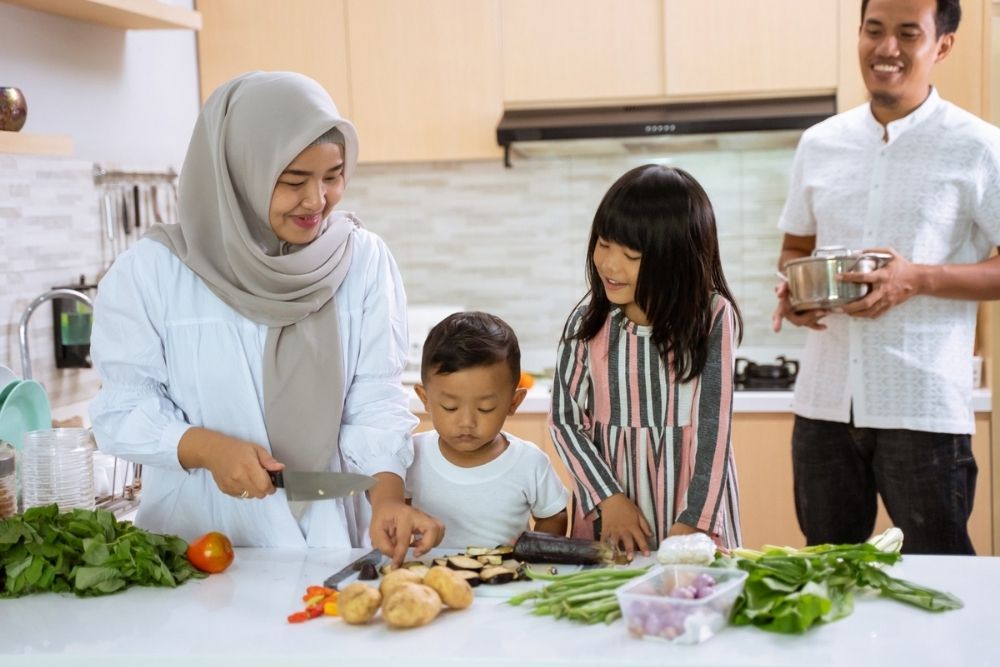Families that cook together laugh together. And learn together. And discover one another in new ways. In addition to learning about measurement, weight, and the chemistry of cooking, family members reap social and emotional health benefits when everyone is involved in the dinner, from recipe selection to food prep to cooking and serving a meal.
- Family cooking time is quality time. Cooking together creates an opportunity for communicating on a regular basis. In between chopping and sautéing you might chat about school, sports, current events, or books and movies.
- Cooking with kids can reduce meal-time battles. Kids are much more likely to enjoy eating what they make. And if they don’t, that’s okay because they will have developed a sense of ownership and they will have tried something new.
- When kids see that cooking can be a fun, creative outlet (like an art project), it’s more interesting for them and they’ll want to do it more often.
- Remember, it’s okay for cooking to get a little messy! Mistakes are inevitable, and you can easily turn those culinary faux pas into learning experiences.
Family Friendly Cooking Tips
- Involve all Family Members. For family cooking to truly be of benefit, all family members need to play a part. Here are a few ways to involve the grown-ups and kids of all ages:
- researching and selecting recipes
- shopping for ingredients
- setting-up the cooking area
- measuring and combining ingredients
- managing and monitoring activity at the stove
- Make it Educational, but Keep it Fun. Even before you all get mixin’ in the kitchen, you can discuss the benefits of choosing locally sourced and organic foods, and you can compare nutrition information for fresh versus canned or frozen foods. Cooking is science in action. Preparing food involves chemistry and math. Following directions involves reading skills, not to mention planning and organizational skills, to help prevent disaster in the kitchen. Discussing what might happen if you substituted different flours or binding agents, can bring science to life, especially for elementary to middle-school age children. During meal prep, the family is learning about the history of a given recipe (food heritage, geography, social customs), food quality and the nutrition provided, etc.
- View Cooking as a Life Skill. The earlier your kids learn to cook, the more self-reliant they become, now and in the future. And, you never know… you might discover there’s a culinary wizard in the house. Young children who develop a passion for cooking could very well establish a culinary career path.
- Healthy Competition. Whether you divide into teams for some healthy competition or some other configuration, think about having a cook-off: best chili, best burger, most creative mac n’ cheese, best presentation, cupcake wars….the list is as long as your imagination is wild!
- Go Global. While your family traditions around food and celebratory occasions are important, in our global world it’s also important to introduce children to the food/meal traditions of other cultures. Here are a few ideas:
- Holidays Around the World. What are the traditional foods of families celebrating in Poland, Russia, the United Kingdom, Mexico, Italy, or France?
- Ringing in a New Year. How is the table decorated on New Year’s Eve? What foods are served? On New Year’s day, how do the people of different cultures honor the new beginning? What about Asian celebrations for ringing in a new year? Compare and contrast the cultural differences for a worldwide holiday.
- Muliti-cultural Celebration. Many cultures incorporate a fast and then break the fast with specific types of foods in celebration of their spiritual traditions. Others celebrate occasions that are not common to the United States. Have your kids research the following foods to identify the culture, the tradition, why the food is used in celebration, and then prepare it together: charoset, dolma, tapas, iftar, lavash, washoku, and krumkake.
- Give Back from Your Kitchen. Set aside time for your family to share their cooking with others. Perhaps your 12 year-old learned to make crunchy homemade dog biscuits–bake a batch of 50 for the local animal shelter. Holiday cookie time? Make several dozen to bring to a soup kitchen or deliver to the elders in your neighborhood or at a local senior center. Keep an eye on local media for ideas for where you can give back from your kitchen.
Allessi, K. Le Moyne College Blog. “Lifestyle: 11 Ways Cooking Brings the Family Together.” posted December 2015. Retrieved 3 October 2021: https://www.theodysseyonline.com/11-ways-cooking-brings-family
FamilyTreeMagazine.com “Food Traditions from Around the Globe.” https://www.familytreemagazine.com/history/holiday-food-traditions/
Video: A Mother and Daughter’s Cooking Journey. https://www.youtube.com/watch?v=161QlciI1CQ
Wander-lush.com “Food Culture: 23 Culinary Traditions fro Around the Globe.” https://wander-lush.org/food-culture-unesco/
TasteofHome.com “89 Authentic Recipes from Around the World.” https://www.tasteofhome.com/collection/travel-around-the-world-in-80-meals/
PurdueUniversity.edu “Cooking as a Family.” Retrieved from eatgathergo.org on 3 Oct 2021. https://www.eatgathergo.org/gather/cooking-as-a-family/

